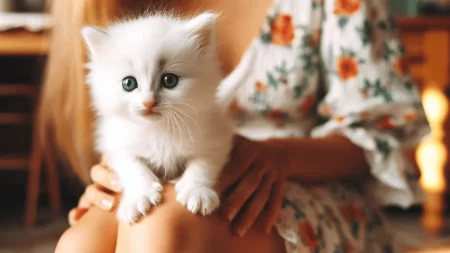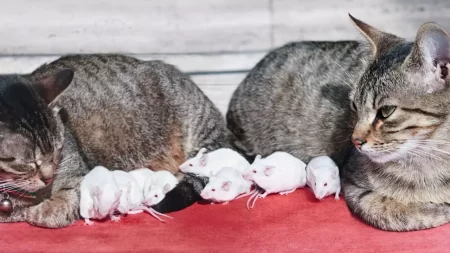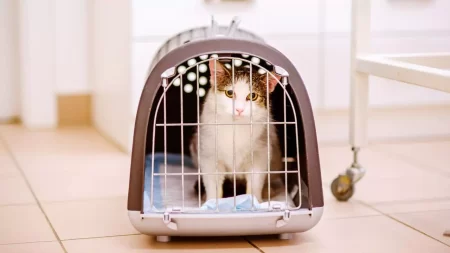Cats often exhibit strange behaviors that their owners find puzzling or concerning. One such behavior is when a cat chews or licks at the air as if eating an invisible meal while also purring happily. While this may seem peculiar, there are several potential reasons cats display this chewing and purring behavior.
Reasons for Cat Chewing on Nothing and Purring
There are a number of explanations for why a cat may chew on nothing while purring. Here are some of the most common causes:
1. Natural Hunting Behavior
Chewing or licking the air is an instinctive hunting behavior for cats. In the wild, cats would chew on their freshly caught prey while purring contentedly. Domestic cats may exhibit “air chewing” because of their natural prey drive even when no food is present. The act of chewing satisfies this innate need to hunt.
2. Stress and Anxiety Reduction
For some cats, chewing or licking motions release endorphins that have a calming effect. Purring also releases endorphins and lowers stress. Air chewing coupled with purring may signal your cat is trying to relieve anxiety, fear or stress through these mechanisms.
3. Dental Issues
If your cat has tooth pain from cavities, gingivitis or other dental problems, it may chew or lick obsessively at nothing. The motion may stimulate circulation to painful areas of the mouth or temporarily distract from dental discomfort. Purring releases endorphins which act as natural painkillers.
4. Nutritional Deficiencies
Cats who lack certain nutrients like fat, protein or vitamins will sometimes lick non-food objects or air. This could indicate pica, a condition that causes appetite stimulation. The purring shows your cat is anticipating eating. Check with your vet to rule out any dietary deficiencies.
5. Teething in Kittens
Kittens go through a teething period just like human babies. Their incoming adult teeth cause swelling and pain in the gums. Chewing and licking motions help relieve some of that discomfort. The purrs are calming despite the teething irritation. This behavior usually resolves as kittens finish teething.
6. Attention-Seeking Behavior
Some cats learn that chewing on nothing elicits a reaction from their owners. The purring ensures you focus your attention on them. Make sure to discourage this attention-seeking behavior to avoid reinforcing it.
7. Self-Medication
In some cases, air chewing and purring could be a cat’s way of self-medicating. If your cat suffers from nausea, the motions may help relieve it. Purring releases endorphins to improve overall wellbeing. Always rule out medical issues if this behavior is new or excessive.
The Meaning Behind Cat Purring
While chewing on nothing is a bit unusual, purring is a common cat behavior. Here are some of the reasons cats purr:
Happiness and Contentment
The most common reason for purring is that a cat is happy, comfortable or feeling content. The purr vibrations signify a cat is in a calm, positive mood. Gentle purring indicates your cat is satisfied with their current environment and situation.
Bonding and Affection
Cats purr as a social signaling mechanism to bond with their owners. The purring helps cats communicate positive emotions like affection, safety and trust to humans. It’s a non-verbal “I love you!” during petting, lap-sitting or caretaking interactions.
Communication
In addition to signaling happiness, purring allows cats to communicate needs or preferences. The unique tone, volume and intensity of purrs can indicate what a cat wants or impose what they desire from others. It’s a meaningful interaction tool between cats and humans.
Pain Relief
While counterintuitive, cats often purr more loudly when injured or ill. The increased purring may help stimulate internal healing as the vibrations travel through a cat’s body. Purring also releases natural pain-relief endorphins to improve comfort.
Anxiety Reduction
The self-soothing nature of purring makes it helpful for reducing stress and anxiety. Like a lullaby calms a crying baby, a cat’s rhythmic purr has pacifying properties to alleviate nervousness, tension or fear they may be experiencing.
How to Address Cat Chewing on Nothing and Purring?
If your cat chews on nothing and purrs excessively, here are some tips for addressing the behavior:
Regular Dental Check-ups
Schedule annual vet dental exams to rule out painful cavities, gum disease or oral tumors triggering chewing motions. Cats are prone to dental problems so regular check-ups are key.
Providing Appropriate Chew Toys
Give your cat outlet for their natural hunting instinct by providing approved chew toys. Interactive toys keep their prey drive satisfied without resorting to chewing on non-food objects.
Ensuring a Balanced Diet
Check with your vet that your cat’s diet includes adequate nutrition to prevent pica chewing caused by deficiencies. Cats have unique nutritional requirements that may mean supplementing commercial cat food.
Providing Mental and Physical Stimulation
Make sure your cat gets sufficient playtime, environmental enrichment and daily activity. Adequate mental and physical stimulation curbs boredom and repetitive behaviors like obsessive chewing.
Addressing Underlying Stress or Anxiety
Try to identify and resolve sources of stress for anxious cats. Reduce environmental stressors, add calming diffusers or pheromones, and give anxious cats “safe spaces” to unwind in.
Seeking Professional Help
For excessive or unexplained chewing/purring, seek advice from your vet. They can assess for underlying medical conditions and recommend solutions like medication, behavioral therapy or environmental changes to stop the behavior. Working with a vet ensures your cat’s needs are met.
In summary, cats chewing on nothing while purring can be perplexing but usually has an explainable cause. By understanding the potential reasons and addressing any underlying issues, cat owners can curb undesirable chewing habits while enjoying their cat’s contented purrs. With some detective work and patience, the chewing and purring should resolve over time or with treatment. Pay attention to any accompanying symptoms and don’t hesitate to consult your veterinarian if the behavior becomes problematic.







